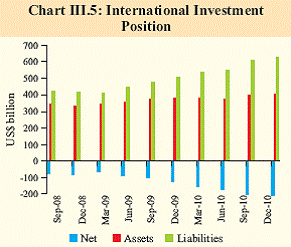Current account deficit (CAD) moderated in Q3 of 2010-11, reflecting significant acceleration
in exports. While concerns on CAD in 2010-11 have receded, the spike in oil prices poses the
risk of CAD widening in 2011-12. Capital flows are expected to improve financing the CAD
comfortably. However, the dominance of portfolio equity flows and the decline in FDI raise
concern over the stability of capital flows. While the earthquake in Japan is unlikely to
significantly affect India, risk of further worsening of the geo-political situation in MENA and
a possible turnaround in global interest rate cycle would have to be factored into macropolicies.
Concerns on CAD have receded, but have
not dissipated
III.1 Current account deficit (CAD) that
amounted to 3.7 per cent of GDP in H1 of 2010-
11 moderated to 2.1 per cent of GDP in Q3
primarily reflecting pick up in exports. With this
trend gaining further pace in Q4, the CAD for
the full year may settle at around 2.5 per cent
of GDP. However, the downward drift could
reverse if the current spurt in global crude oil
prices persists. With a larger CAD, any abrupt
tightening of external financing could put
pressure on the exchange rate, raise cost of
capital and feed through into inflation.
Developments in global economic and financial
market conditions could impact the capital
account, especially if the central banks in
advanced economies (AEs) start withdrawing
monetary accommodation. Such a withdrawal,
however, is likely to raise global interest rates,
reduce leveraged positions in global commodity
markets and so help deflate global commodity
prices.
Global recovery advances but sovereign
balance sheets pose risk
III.2 The global economic recovery is broadly
on track. However, uncertainty remains with
significant sovereign and banking sector default
risks prevailing in parts of Europe. Furthermore, the recovery continues to move at multi-speed
characterised by large output gaps in AEs and
closing or closed gaps in emerging market and
developing economies (EMDEs). More
significantly, unemployment rates have begun
to fall in US and Germany. The risk of double
dip recession has receded. Nevertheless, stillstagnant
real estate markets, stubbornly high
unemployment and possibility of contagion
from weak sovereign balance sheets of
peripheral European countries continue to
present major concerns in the AEs. IMF, in April
2011, has projected the world real GDP growth
to slow down modestly to 4.4 per cent in 2011
from 5 per cent in 2010 (Chart III.1a). The key
downside risk to global growth relates to the
potential for oil prices to surprise further on the
upside because of supply disruptions. Among
the AEs, there was a diverging trend in growth
during the fourth quarter vis-à-vis the previous
quarter (Chart III.1b).
Outlook for capital flows to EMEs suggests
risks from sudden reversals
III.3 While the capital flows to EMEs are
likely to remain strong, they do run the risks of
turning volatile, with possible episodes of
sudden reversals. As strong capital flows in the
first place were caused by the multi-speed
recovery around the world and the consequent
differential exit from accommodative monetary policy, the start of the exit in AEs can result in
increased “home-bias” in investments and
changes in portfolio allocations. US recovery
and the need for massive reconstruction in Japan
can bolster this trend. Net private capital flows
to EMEs, according to the IIF, are estimated to
increase by 6 per cent in 2011 to US $ 960
billion on top of an increase of 50 per cent
during 2010 (IIF, January 2011). Net private
financial flows to EMDEs, according to IMF’s
World Economic Outlook (April 2011), are
projected at US $ 388 billion in 2011 as against
US $ 470 billion in 2010.
World trade recovery continues, while
industrial production regains speed after
stagnation
III.4 World trade and industrial production
slowed during the latter half of 2010, reflecting a global inventory cycle. Recent data show a
mixed picture. Industrial production had begun
to regain speed at the start of the calendar year
(Chart III.1c). However, both the manufacturing
and the services Purchasing Managers’ Index
had dipped in March 2011 in the aftermath of
earthquake in Japan, though the index values
suggest continued expansion. Global trade is
recovering with the value of world merchandise
trade, led by Asia, accelerating perceptibly in
the fourth quarter of 2010 compared to the same
period of 2009 (Chart III.1d). In volume terms,
world trade expanded by 12 per cent in 2010.
World imports of EMDEs are back to pre-crisis
trends, but those of advanced economies
continue to lag. Japan’s disaster is likely to have
some impact on East Asian economies, which
have strong trade and financial links with Japan,
before a reconstruction-led recovery starts.
 |
Diversification in India’s exports augurs
well for trade balance
III.5 The robust growth in India’s exports
reflects diversification of products from labour
intensive manufactures to higher value-added products in engineering and petroleum sectors
and to destinations across emerging markets and
developing economies which led to moderation
in trade deficit during 2010-11(Charts III.2 and 3).
Impact of MENA unrest significant, that of
Japan will be marginal
III.6 The ongoing political unrest in some of
the Middle East and North African (MENA)
countries and the natural disaster in Japan are
not expected to directly affect India’s trade
position as these economies do not have a high
share in India’s international trade; there could,
however, be significant indirect effects arising
from the possible rise in oil prices and other
commodity prices. Oil alone constitutes about
one-third of India’s total imports (Chart III.4
and Table III.1). Further, some transitory impact on investment flows and aid commitments from
Japan may occur.
 |
Table III.1 : India’s Merchandise Trade |
(US$ billion) |
Item |
2009-10 (R) |
2010-11 (P)* |
Absolute |
Growth
(%) |
Absolute |
Growth
(%) |
1 |
2 |
3 |
4 |
5 |
Exports |
178.2 |
-2.5 |
245.9 |
37.6 |
Oil |
28.1 |
2.1 |
42.5 |
51.2 |
Non-oil |
150.1 |
-3.2 |
203.5 |
35.5 |
Imports |
287.4 |
-3.8 |
350.3 |
21.9 |
Oil |
86.8 |
-7.4 |
88.2 |
12.4 |
Non-oil |
200.6 |
-2.2 |
217.1 |
20.4 |
Trade Balance |
-109.2 |
-5.7 |
-104.4 |
-4.4 |
Non-Oil Trade Balance |
-50.5 |
1.2 |
-41.8 |
-6.9 |
* : For oil and non-oil imports and non-oil trade balance data pertain to April-February.
R : Revised. P : Provisional.
Source: DGCI&S. |
CAD moderation aided by net invisibles
receipts too
III.7 Both the trade and invisible accounts
contributed to the improvement in current
account during Q3 of 2010-11. The higher
invisibles surplus was mainly on account of an
improvement in net services exports and private
transfers (Table III.2). As a result, the CAD
moderated from 3.7 per cent of GDP in H1 of
2010-11 to 3.1 per cent of GDP during April-
December 2010 which was, however, higher than 2.6 per cent of GDP during April-December
2009.
Table III.2 : India’s Balance of Payments |
(US $ billion) |
Item |
2009-10 |
2009-10 (PR) |
2010-11 |
Q1 |
Q2 |
Q3 |
Q4 |
Q1 (PR) |
Q2 (PR) |
Q3 (P) |
1 |
2 |
3 |
4 |
5 |
6 |
7 |
8 |
9 |
1. |
Exports |
182.2 |
39.2 |
43.4 |
47.2 |
52.5 |
55.3 |
51.8 |
66.0 |
2. |
Imports |
300.6 |
65.4 |
73.0 |
78.1 |
84.1 |
88.0 |
89.6 |
97.5 |
3. |
Trade Balance (1-2) |
-118.4 |
-26.3 |
-29.6 |
-30.9 |
-31.6 |
-32.8 |
-37.8 |
-31.6 |
4. |
Net Invisibles |
80.0 |
22.1 |
20.4 |
18.7 |
18.8 |
20.3 |
21.0 |
21.9 |
5. |
Current Account Balance (3+4) |
-38.4 |
-4.2 |
-9.2 |
-12.2 |
-12.8 |
-12.5 |
-16.8 |
-9.7 |
6. |
Gross Capital Inflows |
345.7 |
77.8 |
96.0 |
81.6 |
90.3 |
95.3 |
112.6 |
174.2 |
7. |
Gross Capital Outflows |
292.3 |
74.2 |
76.7 |
66.9 |
74.5 |
78.8 |
91.3 |
159.3 |
8. |
Net Capital Account (6-7) |
53.4 |
3.7 |
19.3 |
14.6 |
15.8 |
16.6 |
21.3 |
14.9 |
9. |
Overall Balance (5+8)# |
13.4 |
0.1 |
9.4 |
1.8 |
2.1 |
3.7 |
3.3 |
4.0 |
# : Overall balance also includes errors and omissions apart from items 5 and 8.
PR : Partially Revised. P : Provisional. |
III.8 Services exports recorded a strong
growth during October-December 2010 over the
corresponding quarter of the previous year led
by travel, transportation, business, financial and
software services. While net business services
receipts gradually improved over the quarters,
software exports rebounded strongly in Q3 of
2010-11. The robust growth in software exports
could be attributed to the transformation in
Indian information technology (IT) service
offerings from application development and
maintenance to provision of full servicescomprising testing, infrastructure, consulting
and system integration as well as the benefits
of geographical diversification. Investment
income receipts declined significantly over the
corresponding period of the previous year,
mainly due to the persistence of lower interest
rates abroad. Private transfer receipts continued
to be robust during the year so far. On the other
hand, invisibles payments in Q3 were also higher due to larger payments under almost all
components of invisibles, particularly
investment income and business services. Net
invisibles balance improved significantly in Q3
of 2010-11 over the corresponding quarter of
the preceding year (Table III.3).
Table III.3 : Net Invisibles |
(US $ billion) |
Item |
October-December |
April-December |
2009-10
(PR) |
2010-11
(P) |
2009-10
(PR) |
2010-11
(P) |
1 |
2 |
3 |
4 |
5 |
1. Services |
8.2 |
12.2 |
27.3 |
34.2 |
Of which: |
|
|
|
|
Travel |
1.1 |
1.5 |
1.8 |
2.8 |
Transportation |
-0.4 |
-0.3 |
-0.3 |
-0.5 |
Software Services |
12.9 |
14.7 |
34.2 |
39.9 |
Business Services |
-2.1 |
-0.9 |
-4.9 |
-3.1 |
Financial Services |
-0.4 |
-0.1 |
-0.5 |
-0.4 |
2. Transfers (Private) |
12.8 |
13.4 |
39.5 |
39.5 |
3. Income |
-2.5 |
-3.9 |
-5.8 |
-10.6 |
Investment Income |
-2.2 |
-3.6 |
-5.2 |
-9.9 |
Compensation of Employees |
-0.3 |
-0.3 |
-0.5 |
-0.8 |
Total (1+2+3) |
18.5 |
21.7 |
61.0 |
63.1 |
PR: Partially Revised. P: Preliminary. |
Composition and volatility in capital flows
remain a concern
III.9 Although the net capital flows in Q3 of
2010-11 remained broadly the same as in the
corresponding quarter of the preceding year, the
composition and volatility of capital flows
raised some concerns (Table III.4). For example,
the FDI flows moderated. This was mainly on
account of lower FDI inflows under services
and ‘construction, real estate and mining’.
Though net FII flows were higher, they were
volatile with several bouts of net outflows
during the quarter.
Table III.4 : Net Capital Flows |
(US $ billion) |
Item |
October-December |
April-December |
2009-10 (PR) |
2010-11 (P) |
2009-10 (PR) |
2010-11 (P) |
1 |
2 |
3 |
4 |
5 |
Net Capital flows |
14.6 |
14.9 |
37.6 |
52.7 |
Of which: |
|
|
|
|
1. Foreign Direct Investment (FDI) |
3.0 |
2.1 |
15.4 |
7.6 |
Inward FDI |
7.2 |
5.3 |
27.0 |
18.0 |
Outward FDI |
-4.2 |
-3.2 |
-11.6 |
-10.4 |
2. Portfolio Investment |
5.7 |
6.3 |
23.6 |
30.1 |
Of which: |
|
|
|
|
FIIs |
5.3 |
7.2 |
20.5 |
29.5 |
ADR/GDRs |
0.5 |
0.2 |
3.2 |
1.8 |
3. External Assistance |
0.8 |
1.2 |
1.9 |
4.2 |
4. External Commercial Borrowings |
1.7 |
3.6 |
2.4 |
9.3 |
5. NRI Deposits |
0.6 |
0.2 |
3.5 |
2.3 |
6. Short-term Trade Credit |
3.2 |
1.5 |
3.1 |
8.5 |
PR: Partially Revised. P: Preliminary. |
III.10 Certain lead indicators of capital flows
suggest that FDI inflows continued to be
moderate during Q4 of 2010-11. FII flows also
remained moderate being negative initially, but
turned positive thereafter. ECB approvals
increased on the back of strong domestic demand and interest rate differentials (Table
III.5). Notwithstanding some easing of pressures
with respect to financing of CAD, the
moderation in equity inflows coupled with
rising debt flows during 2010-11 so far poses
risks to sustainability. Any unforeseen global
developments may affect CAD and its financing
and, therefore, warrant close monitoring of the
evolving situation.
Table III.5 : Capital Flows in 2010-11 so far |
(US $ billion) |
Component |
Period |
2009-10 |
2010-11 |
1 |
2 |
3 |
4 |
FDI to India |
April-February |
33.8 |
25.9 |
FIIs (net) |
April-March |
29.0 |
29.4 |
ADRs/GDRs |
April-March |
3.3 |
2.0 |
ECB Approvals |
April-March |
20.7 |
25.6 |
NRI Deposits (net) |
April-March |
2.9 |
3.2 |
FDI : Foreign Direct Investment.
FII : Foreign Institutional Investors.
ECB : External Commercial Borrowings.
ADR : American Depository Receipts.
GDR : Global Depository Receipts.
NRI : Non Resident Indians. |
Higher absorption of capital inflows leaves
modest reserve accretion
III.11 As net capital inflows were in excess of
CAD, India’s foreign exchange reserves
increased modestly during Q3 of 2010-11.
India’s foreign exchange reserves stood at US$
309.7 billion as on April 22, 2011. Net capital
inflows, though relatively higher, were largely
absorbed by higher CAD during April-
December 2010 and did not complicate the
monetary management.
Indicators of Real Effective Exchange Rate
(REER) exhibit appreciation
III.12 The real effective exchange rate (REER)
indices for 6-currency, 30-currency and 36-
currency baskets exhibited appreciation of the
Indian rupee during 2010-11. The 6-currency
index showed maximum appreciation
compared to other indices reflecting higher
inflation differential with these countries (Table III.6). The REER appreciation may not
have implications for external sector
competitiveness as there are a host of other
factors such as global recovery leading to a
pick-up in demand as well as diversification
of the export basket and across destinations
and various Government initiatives that have
a bearing on the export performance.
Table III.6 : Nominal and Real Effective Exchange Rates-Trade Based
(Base : 2004-05=100) |
(Per cent, appreciation+/depreciation-) |
|
Index |
Year-on-Year Variation (Average) |
| April 15
2011 P |
2008-09 |
2009-10 P |
2010-11 P |
1 |
2 |
3 |
4 |
5 |
36-REER |
102.3 |
-9.9 |
-3.1 |
7.7 |
36-NEER |
92.8 |
-10.9 |
-2.6 |
2.9 |
30-REER |
93.7 |
-10.2 |
-4.6 |
4.5 |
30-NEER |
94.7 |
-8.3 |
-2.2 |
1.0 |
6-REER |
115.8* |
-9.3 |
-0.01 |
12.7 |
6-NEER |
90.8* |
-13.6 |
-3.4 |
5.7 |
Rs/USD |
44.5 |
-12.5 |
-3.1 |
4.1 |
Rs/USD (end-March) |
44.7 |
-21.5 |
12.9 |
1.1 |
NEER : Nominal Effective Exchange Rate.
REER : Real Effective Exchange Rate.
P : Provisional.
* : Data pertain to March 2011.
Note : Rise in indices indicates appreciation of the rupee and vice versa. |
External debt rises
III.13 External debt stock as at end-December
2010 showed an increase of around 14 per cent
over the level of end-March 2010 reflecting
increases in ECBs and short-term credit as well
as valuation effects due to depreciation of the
US dollar against other major currencies
(Table III.7).
Table III.7 : India’s External Debt |
(US$ billion) |
Item |
External debt outstanding |
Variation |
End-
March
2009 |
End- March
2010 (PR) |
End-
December
2010 (P) |
December 2010 over
March 2010 |
Amount |
Per cent |
1 |
2 |
3 |
4 |
5 |
6 |
1. Multilateral |
39.5 |
42.9 |
47.6 |
4.7 |
11.0 |
2. Bilateral |
20.6 |
22.6 |
25.2 |
2.6 |
11.5 |
3. IMF |
1.0 |
6.0 |
6.1 |
0.1 |
1.7 |
4. Trade Credit |
14.5 |
16.9 |
19.0 |
2.1 |
12.4 |
5. Commercial Borrowings |
62.4 |
70.9 |
84.7 |
13.8 |
19.5 |
6. NRI Deposits |
41.6 |
47.9 |
50.7 |
2.8 |
5.8 |
7. Rupee Debt |
1.5 |
1.7 |
1.6 |
-0.1 |
-5.9 |
8. Long-Term Debt (1 to 7) |
181.2 |
208.8 |
234.9 |
26.1 |
12.5 |
9. Short-Term Debt |
43.4 |
52.3 |
62.6 |
10.3 |
19.7 |
Total Debt (8+9) |
224.6 |
261.2 |
297.5 |
36.3 |
13.9 |
PR : Partially Revised. P : Provisional.
Source: Ministry of Finance, Government of India and Reserve Bank of India. |
III.14 The debt sustainability indicators
witnessed a modest deterioration at end-
December 2010 on account of the continued
dominance of debt creating flows (Table III.8).
Net international liabilities increase
III.15 Large increase in India’s net
international liabilities during the quarter, despite moderation in CAD, mainly reflected
the valuation effects due to exchange rate
movements (Chart III.5).
Oil prices and capital flow volatility to shape
external balance
III.16 Hardening of international crude oil
prices on the back of geo-political concerns pose
risks to current account balance during 2011-12. Higher growth in software exports and
robust transfer receipts may provide some
cushion. Financing of the current account,
however, may not be a problem as capital flows
are likely to improve considering India’s longrun
growth prospects and policies supporting
FDI, as also larger FII investments in debt
markets. Nonetheless, the composition and
volatility of capital flows could have
implications for external sector vulnerability,
warranting close monitoring.
Table III.8 : External Sector Vulnerability Indicators |
(Per cent) |
Indicator
|
End-December 2009 |
End-March 2010 |
End-September 2010 |
End-December 2010 |
1 |
2 |
3 |
4 |
5 |
1. |
Total Debt/GDP |
- |
18.0 |
- |
- |
2. |
Ratio of Short-term to Total Debt (Original Maturity) |
18.0 |
20.0 |
20.9 |
21.0 |
3. |
Ratio of Short-term to Total Debt (Residual Maturity) |
- |
41.2 |
42.9 |
- |
4. |
Ratio of Concessional Debt to Total Debt |
17.7 |
16.8 |
16.0 |
15.6 |
5. |
Ratio of Reserves to Total Debt |
112.8 |
106.8 |
101.4 |
99.9 |
6. |
Ratio of Short-term Debt to Reserves |
15.7 |
18.8 |
20.6 |
21.1 |
7. |
Reserves Cover of Imports (in months) |
12.4 |
11.1 |
10.3 |
9.9 |
8. |
Reserves Cover of Imports and Debt Service Payments (in months) |
11.6 |
10.5 |
9.8 |
9.4 |
9. |
Debt Service Ratio (Debt Service Payments to Current Receipts) |
5.1 |
5.5 |
3.8 |
3.9 |
|



























